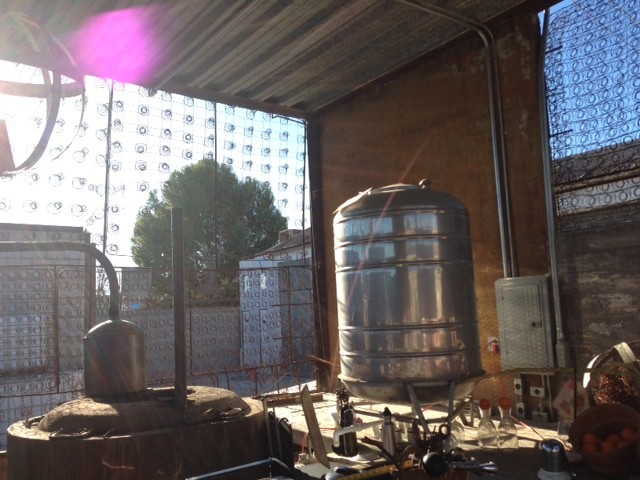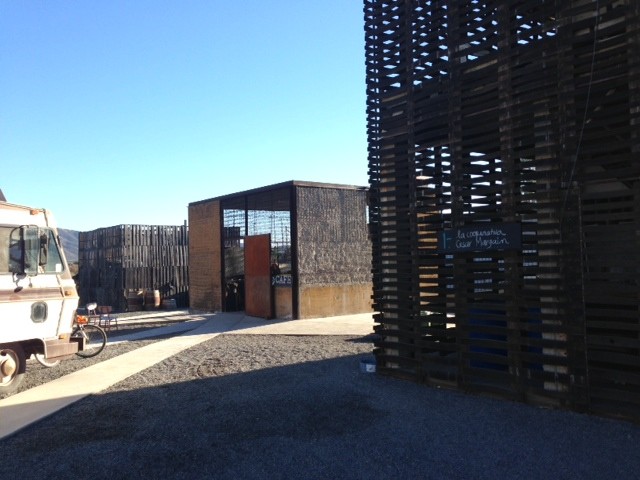
In the center of the wine and olive oil laboratory known as La Escuelita (but officially as la Estación de Oficios de El Porvenir) stands a wooden building with mattress springs for walls. Inside is a brown clutter of detritus: a Christmas tree made of upturned wine bottles stands anachronistically next to a wine barrel; colored bottles seem to be everywhere, except where a small passthrough allows the barista to pass through the fruits of his labor.
This is Azul Café, the home of the best coffee in the Valle de Guadalupe, and where Southern Californians can go to taste the impending Mexican coffee revolution.
]
Mexico has grown coffee for a very, very long time, and the United States buys most of it, but it was always just commingled together and sold under American brands; It was Arabica, sure, but there was no way to tell where the beans came from.
The bean started to crack, as it were, when the Estado Libre y Soberano de Veracruz de Ignacio de la LLave, better known to us as Veracruz, embarked upon a marketing campaign on Spanish-language television that would have done Madison Avenue proud. It worked, too–the commercials, which featured fast-flashing images of Veracruz's culture set to the harp-heavy local regional music, son jarocho, caused an almost immediate surge in sales, so much so that it became hard to find Veracruz coffee.
The next region that stepped up to fill the seemingly-endless U.S. thirst for coffee was Soconusco, which is grown in the mountains that overlook the Pacific Ocean in Chiapas, near Mexico's border with Guatemala. Soconusco beans are known for their incredibly fruity and light flavor; these are not beans you dark roast for espresso.
La Monarca, a mini-chain of panaderías in Los Angeles, sells coffee from Oaxaca, as do many Oaxacan restaurants, making café fino de Oaxaca the next fetish from that southern, culture-rich state.
There's more, much more; coffee is grown in at least nine of the 31 states of Mexico, and as far north as San Luis Potosí, less than a day's drive from the US border. If you want to try single-source Mexican coffees, though, you have to go to Mexico. Unknown on these shores are coffees from the highlands of Puebla, east of Mexico City; coffees from the almost completely mountainous state of Guerrero, where Acapulco and Ixtapa-Zihuatanejo are.

You do not, however, have to hop a Volaris flight to try them; you just have to drive into the Valle de Guadalupe. Here is the cradle of wine and olive oil making, where nearly everyone who produces these days got their start.
The coffee at Azul Café isn't hipster third-wave coffee, either; there are no siphons, no Rube Goldberg-like cold-drip bulbs, no gram scales with precisely-calibrated machines that hum, whiz and burble the stuff into the cup. There is boiling water, and there are coffee beans; there is milk, and there is sugar.
Try it black, though; the beans are roasted to a lighter roast than you might be used to, but that brings forward the intense fruitiness of the coffee and allows you to taste the terroir (surely there must be a Spanish word for this?). You'll notice a big difference between Los Altos and Soconusco, both from Chiapas; the Oaxacan is earthier than the Guerrerense, but the Guerrerense packs a caffeinated punch you can practically taste.
Once you're convinced, you can purchase the beans for $8 US per pound, an absolutely unheard-of price for single-origin coffee in the United States; chances are that if it takes more than about ten minutes for your coffee beans to be handed to you, it's being roasted to order–score!
Estación de Oficios de El Porvenir, or La Escuelita, is located at the stop sign in the village of El Porvenir, 4 km west of Francisco Zarco on the paved road.
Follow Stick a Fork In It on Twitter @ocweeklyfood or on Facebook! And don't forget to download our free Best Of App here!

